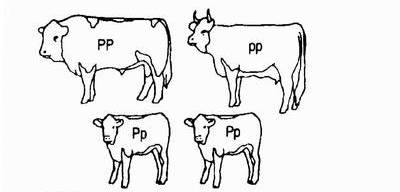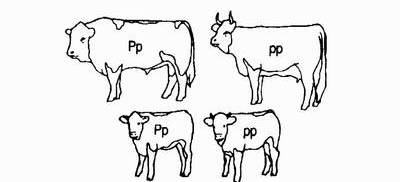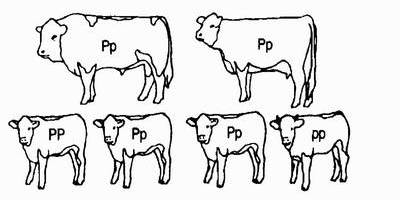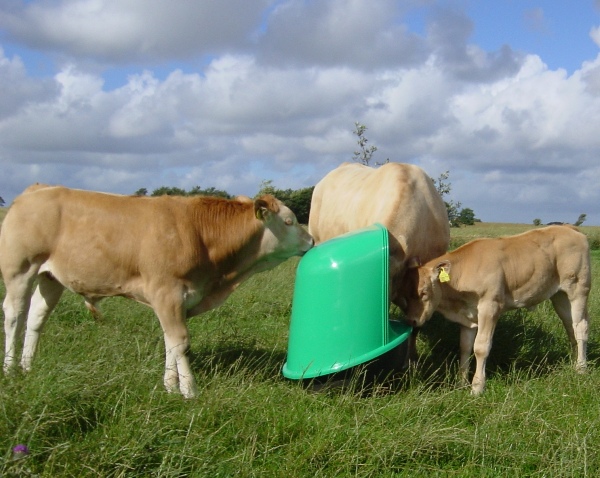

|
|
Inheritance of the polled trait The inheritance of the polled trait is determined by a single gene pair, where one of the genes comes from the sire and the other from the dam. BABS Polled Blonde uses the international abbreviations
Both homozygoitic and heterozygotic animal are phenotypically without horns because the polled gene (P) dominates over the recessive gene for horns (p). The following small scheme is made in order to illustrate the possibilityes for combination of polled and horned animals: Here a homozygotic sire (PP) is crossed with a heterozygotic dam (Pp).
It is from the scheme seen that the combination PP x Pp gives 50 % homozygotic (PP) offspring and 50 % heterozygotic (Pp) offspring. The offspring will be 100% heterozygotic polled (Pp) if a homozygotic polled bull (PP) is crossed with a horned cow (pp):
The crossing of two homozygotic polled animals (PP) gives naturally 100 % homozygotic (PP) polled offspring. The crossing with a homozygotic bull (PP) gives - as seen from the above three examples - always offspring without horns!!! The next two examples illustrates the results of the use of a heterozygotic polled sire (Pp): A heterozygotic bull (Pp) will if crossed with a horned cow (pp) give 50 % heterozygotic (Pp) afkom og 50 % horned offspring:
Two animals, which both are heterozygotic polled (Pp) gives 25 % homozygotic polled (PP) offspring, 50 % heterozygotic polled (Pp) offsping and 25 % horned offsping as seen from the following figure:
The use of a heterozygotic polled bull (Pp) will hence lead to offsping where half or three quarter of them are without horns, if the cows are horned, respectively heterozygotic polled. It is important to note that all the illustrated examples are theoretic; the relation between horned and polled animals will in practice vary, just like there is a variation in the ratio between male and female calfs. All BABS animals are DNA-tested for the polled trait in order to determine their genotype. This laboratory test is based on so-calld genetic markers and not on the polled gene itself. The security of the test to determine whether an animal is heterozygotic or homozygotic polled is therefore not 100%, but calculated to 95%. However, a horned animal will for sure always be homozygotic horned (pp) and be without polled genes. The polled trait is a functional trait that brings added value to the breed There is a worldwide tendency for the elimination of horns in all cattle breeds through the use of naturally polled animals. Dehorning time consuming and painful for the animal, causing stress and weight loss, besides exposing them to various infections, and not of least importance: Dehorning is expensive, which these examples from Denmark illustrates:
If horns were necessary for defence purpose in a wild environment, today a naturally polled animal brings many advantages. Management of polled herds is easy and friendly, as herds are more homogeneous and it is possible to gather more animals at one time in the corral or in a truck for transportation. The polled cattle also presents less injuries from fights, preserving their coats for the leather industry. As a result of these advantages, the number of genetically polled cattle in commercial herds is rapidly increasing.
MicroFeeders mineral feeder is an example of a modern production system that does not suit horned cattle Origin of the polled trait Polled cattle apparently existed in Scotland before recorded history because the likeness of such cattle is found in prehistoric carvings of Aberdeen and Angus. Historians state that there were hornless cattle in Siberia centuries earlier. A hornless race of cattle was depicted in Egypt by sculptors and painters of that ancient civilization. Some historians feel that the Aberdeen-Angus breed and the other Scottish breeds sprang from the aboriginal cattle of the country and that the breeds as we find them today are indigenous to the districts in which they are still found. |
||||||||||||||




